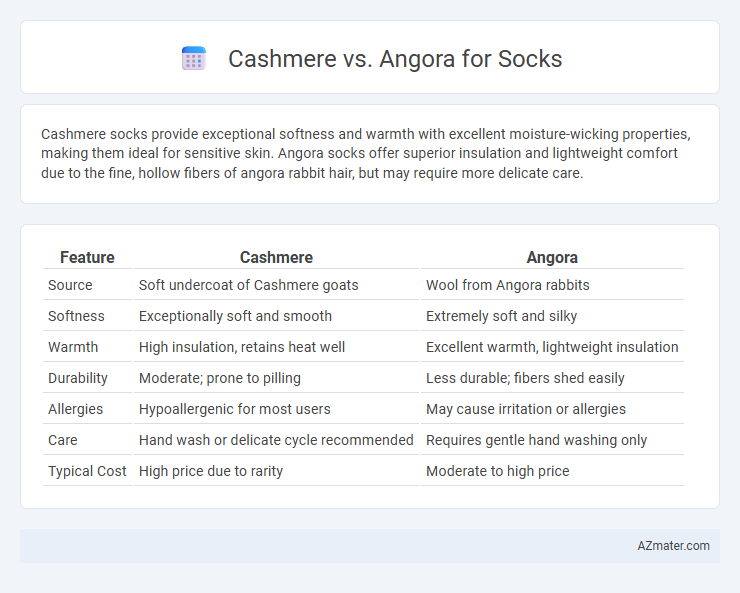Cashmere socks provide exceptional softness and warmth with excellent moisture-wicking properties, making them ideal for sensitive skin. Angora socks offer superior insulation and lightweight comfort due to the fine, hollow fibers of angora rabbit hair, but may require more delicate care.
Table of Comparison
| Feature | Cashmere | Angora |
|---|---|---|
| Source | Soft undercoat of Cashmere goats | Wool from Angora rabbits |
| Softness | Exceptionally soft and smooth | Extremely soft and silky |
| Warmth | High insulation, retains heat well | Excellent warmth, lightweight insulation |
| Durability | Moderate; prone to pilling | Less durable; fibers shed easily |
| Allergies | Hypoallergenic for most users | May cause irritation or allergies |
| Care | Hand wash or delicate cycle recommended | Requires gentle hand washing only |
| Typical Cost | High price due to rarity | Moderate to high price |
Introduction: Comparing Cashmere and Angora Socks
Cashmere and Angora socks offer luxurious warmth and softness, yet differ significantly in texture and durability. Cashmere, sourced from the undercoat of Cashmere goats, provides a lightweight, breathable, and highly insulating fiber ideal for sensitive skin. Angora, derived from Angora rabbits, is exceptionally fluffy and warm but requires careful maintenance due to its delicate nature and tendency to shed.
What is Cashmere? Origins and Qualities
Cashmere is a luxurious fiber obtained from the undercoat of Cashmere goats primarily found in Mongolia, China, and parts of the Himalayas, prized for its exceptional softness, warmth, and lightweight feel. The fine fibers are typically 14-19 microns in diameter, which contributes to their superior insulation and comfort compared to regular wool. Cashmere socks offer exceptional thermal regulation and durability, making them ideal for cold weather while maintaining breathability and a gentle touch on the skin.
What is Angora? Origins and Properties
Angora wool originates from the Angora rabbit, known for its silky texture and exceptional softness. This fiber is lightweight, highly insulating, and has a natural sheen that enhances the comfort and luxury of socks. Angora's fine hairs create warmth without bulk, making it ideal for cozy, breathable socks that retain moisture well.
Warmth and Insulation: Which Fiber Performs Better?
Cashmere socks provide exceptional warmth thanks to their fine, natural fibers that trap heat efficiently, making them ideal for cold climates. Angora, derived from rabbit fur, boasts superior insulation due to its hollow fiber structure, which retains body heat more effectively than cashmere. While both fibers excel in thermal properties, angora typically outperforms cashmere in insulation, delivering a higher warmth-to-weight ratio for socks.
Softness and Comfort: Angora vs. Cashmere on Your Feet
Angora fibers offer exceptional softness and a plush feel, providing a luxurious comfort that gently cushions your feet. Cashmere, known for its fine, silky texture, offers warmth and breathability, making it ideal for all-day wear. While both materials deliver superior comfort, Angora's lightweight fluffiness excels in softness, whereas Cashmere provides a balanced combination of softness and durability for socks.
Durability and Longevity in Everyday Wear
Cashmere socks offer moderate durability with a soft texture but tend to wear faster under frequent use due to their fine fibers. Angora socks, made from rabbit hair, provide exceptional warmth and softness but have lower abrasion resistance, leading to quicker thinning and pilling in everyday wear. For long-lasting socks, blends that combine cashmere or angora with stronger fibers like nylon or wool significantly enhance durability and maintain comfort.
Breathability and Moisture-Wicking Abilities
Cashmere offers exceptional softness with moderate breathability, making it comfortable for socks but less efficient at moisture-wicking compared to other fibers. Angora excels in lightweight warmth and superior moisture-wicking properties due to its hollow fiber structure, keeping feet dry and comfortable. Choosing angora socks enhances breathability and moisture management, ideal for extended wear in varied conditions.
Hypoallergenic Considerations for Sensitive Skin
Cashmere socks offer a hypoallergenic advantage due to their fine, protein-based fibers that are less likely to cause irritation or allergic reactions, making them ideal for sensitive skin. Angora wool, derived from the Angora rabbit, contains lanolin which can trigger allergies in sensitive individuals, potentially causing itching or redness. For those with sensitive skin, cashmere provides a softer, gentler option, reducing the risk of discomfort compared to angora.
Cost and Value: Cashmere vs. Angora Sock Investment
Cashmere socks generally come at a higher price point due to the luxurious softness and durability of cashmere fibers, making them a worthwhile investment for long-term comfort and warmth. Angora socks, derived from rabbit fur, tend to be less expensive but may wear out faster, offering less durability and value over time. When considering cost versus longevity, cashmere socks provide better value for those seeking premium quality and sustained performance.
Sustainability and Ethical Sourcing of Cashmere and Angora
Cashmere socks often raise sustainability concerns due to overgrazing by cashmere goats, which can lead to land degradation and habitat loss, though some brands prioritize ethically sourced, sustainably farmed cashmere with traceability certifications. Angora wool involves animal welfare issues since traditional harvesting methods can cause stress to rabbits; however, sustainable alternatives include gathering shed fibers without harming the animals, and brands committed to cruelty-free sourcing standards. Consumers seeking eco-friendly and ethically produced socks should look for certifications such as Responsible Wool Standard (RWS) for cashmere and cruelty-free or humane treatment labels for angora products.

Infographic: Cashmere vs Angora for Socks
 azmater.com
azmater.com